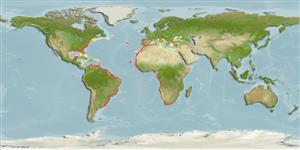Elasmobranchii (Haie und Rochen) (sharks and rays) >
Myliobatiformes (Stingrays) >
Gymnuridae (Butterfly rays)
Etymology: Gymnura: Greek, gymnos = naked + Greek, oura = tail (Ref. 45335).
More on author: Linnaeus.
Environment: milieu / climate zone / depth range / distribution range
Ökologie
seewasser; brackwasser demersal; tiefenbereich 5 - 100 m (Ref. 6808). Subtropical; 47°N - 39°S, 98°W - 42°E
Western Atlantic: southern New England, USA, Brazil (Ref. 7251) to Argentina (Ref. 58839). Eastern Atlantic: Portugal to Ambriz, Angola (including the Mediterranean, Black Sea, and the Madeira and Canary islands).
Size / Gewicht / Alter
Maturity: Lm ? range ? - ? cm
Max length : 400 cm WD Männchen/unbestimmt; (Ref. 3709); common length : 200 cm WD Männchen/unbestimmt; (Ref. 3709); max. veröff. Gewicht: 60.0 kg (Ref. 4699)
Tail short armed with spine. Disk very broad. Very low dorsal and ventral finfolds on tail (Ref. 7251). Disk dark brown to grayish, lower surface of disc and of pelvic fins white, brownish, rosy or rusty cast. Tail white or rosy white below (Ref. 6902).
Maximum length measured is 140 cm (Ref. 5377). Occurs over sand and mud. Feeds on fishes, crustaceans, mollusks and plankton. Ovoviviparous, gestation lasting about 6 months with 4 to 7 embryos produced per female (Ref. 6676).
Exhibit ovoviparity (aplacental viviparity), with embryos feeding initially on yolk, then receiving additional nourishment from the mother by indirect absorption of uterine fluid enriched with mucus, fat or protein through specialised structures (Ref. 50449). Distinct pairing with embrace (Ref. 205).
Bauchot, M.-L., 1987. Raies et autres batoides. p. 845-886. In W. Fischer, M.L. Bauchot and M. Schneider (eds.) Fiches FAO d'identificationpour les besoins de la pêche. (rev. 1). Mèditerranée et mer Noire. Zone de pêche 37. Vol. II. Commission des Communautés Européennes and FAO, Rome. (Ref. 3261)
IUCN Rote Liste Status (Ref. 130435)
Bedrohung für Menschen
Harmless
Nutzung durch Menschen
Fischereien: weniger kommerziell; Sportfisch: ja
Mehr Information
ReferenzenAquakulturAquakultur ProfilZuchtlinienGenetikElectrophoresesVererbbarkeitKrankheitenVerarbeitungNutrientsMass conversion
PartnerBilderStamps, Coins Misc.LauteCiguateraGeschwindigkeitSchwimmstilKiemenoberflächeOtolithsGehirngrößeSehfähigkeit
Tools
Zusatzinformationen
Download XML
Internet Quellen
Estimates based on models
Preferred temperature (Ref.
123201): 14.9 - 27.8, mean 23.6 °C (based on 860 cells).
Phylogenetic diversity index (Ref.
82804): PD
50 = 0.5000 [Uniqueness, from 0.5 = low to 2.0 = high].
Bayesian length-weight: a=0.01122 (0.00613 - 0.02054), b=3.11 (2.94 - 3.28), in cm total length, based on LWR estimates for this species & (Sub)family-body (Ref.
93245).
Trophic level (Ref.
69278): 4.5 ±0.1 se; based on diet studies.
Widerstandsfähigkeit (Ref.
120179): sehr niedrig, Verdopplung der Population dauert mehr als 14 Jahre. (Fec 4-7).
Fishing Vulnerability (Ref.
59153): Moderate to high vulnerability (51 of 100).
Climate Vulnerability (Ref.
125649): High vulnerability (60 of 100).
Nutrients (Ref.
124155): Calcium = 10.2 [1.9, 47.1] mg/100g; Iron = 0.577 [0.144, 1.583] mg/100g; Protein = 23.6 [20.2, 26.5] %; Omega3 = 0.252 [0.073, 0.785] g/100g; Selenium = 28.7 [8.6, 87.8] μg/100g; VitaminA = 3.86 [1.23, 11.42] μg/100g; Zinc = 0.398 [0.197, 0.731] mg/100g (wet weight);
